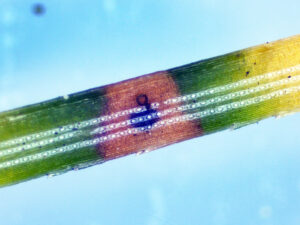
White pine with yellowing needles; new growth is not affected. / Photo Credit: Wisconsin DNR.
By Linda Williams, DNR Forest Health Specialist, Woodruff; Linda.Williams@wisconsin.gov or 920-360-0665
White pine in north central Wisconsin, as well as scattered areas elsewhere in the state, have many needles that are bright yellow. Brown spot needle blight (Lecanosticta acicula, previously known as Mycosphaerella dearnessii) is the primary suspect, although samples have been sent to the Wisconsin Department of Natural Resources (DNR) Forest Health laboratory to determine if other fungal species are present.
Brown spot needle blight only infects older needles, so new growth is not impacted. The symptoms are worse in the lower canopy, typical for fungal needle diseases.

A diseased needle under the microscope shows a black spot with fungal material. / Photo Credit: Wisconsin DNR.
These yellow needles will drop from the trees, leaving the crowns relatively thin until the new growth can fully expand and fill in the crown again. The last time Wisconsin had a significant problem with brown spot needle blight was in 2020.
Losing a large number of needles can put stress on these trees. Yard trees that were severely impacted should be watered if we continue to have dry, droughty conditions. Trees in forests may take a couple of years to get a full complement of needles back as long as defoliation does not occur again the following year.

Brown spot needle blight symptoms are worse in the lower parts of the canopy. / Photo Credit: Wisconsin DNR.
